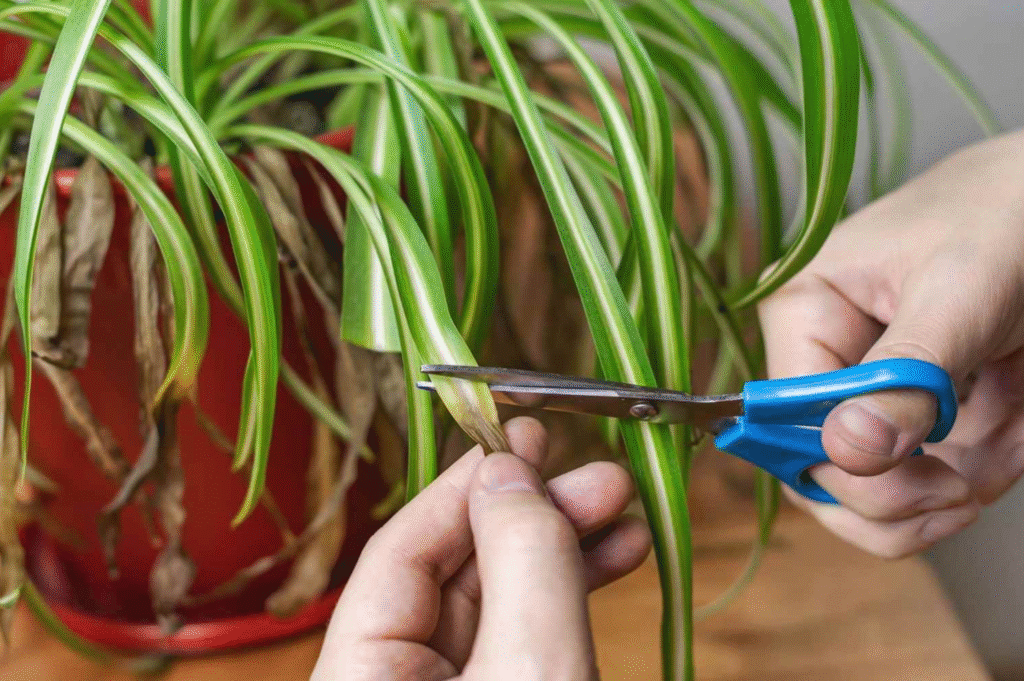Spider plants (Chlorophytum comosum) are known for their easy care and bright green leaves, but sometimes you might notice the leaf tips or edges turning brown. If your spider plant’s leaves are starting to lose their fresh and healthy look. You’re not alone! This is one of the most common problems plant owners face.
In this guide, we’ll explain why your spider plant is turning brown, the possible causes and simple fixes to get it back to its healthy, lush state.
Why Is My Spider Plant Turning Brown?
The most common reasons spider plant leaves turn brown are overwatering, low humidity, direct sunlight, fluoride in tap water, and poor soil drainage. Identify the cause by checking your plant’s care routine and adjust watering, lighting, or humidity as needed to fix the problem.
Common Reasons Why Spider Plant Leaves Turn Brown
Let’s break down the possible causes one by one, so you can figure out what’s affecting your plant.
1. Overwatering
Too much water is the most frequent cause of brown tips and edges on spider plant leaves. When the soil stays soggy for too long, roots can suffocate or rot, leading to stressed, browning leaves.
Fix:
Let the top 1-2 inches of soil dry out before watering again. Use a well-draining potting mix and make sure the container has drainage holes.
2. Fluoride or Chlorine in Tap Water
Spider plants are sensitive to chemicals like fluoride and chlorine, often found in tap water. Over time, these chemicals can build up in the soil and cause brown leaf tips.
Fix:
Use filtered water, rainwater, or leave tap water out overnight to let chemicals evaporate before watering your plant.
3. Low Humidity
Spider plants prefer moderate humidity levels. If your indoor air is too dry, especially during winter when heaters are running, the leaf tips can dry out and turn brown.
Fix:
- Mist the plant regularly
- Place a humidity tray nearby
- Group it with other plants to raise humidity
4. Direct Sunlight Exposure
Although spider plants love bright, indirect light, direct sunlight can scorch their leaves, causing brown or crispy tips and edges.
Fix:
Move your plant to a spot with bright but filtered light, like near an east-facing window or a few feet away from a bright window with curtains.
5. Poor Soil Drainage
If your spider plant is in a heavy, compacted soil that holds too much water, it can cause root stress and browning leaves.
Fix:
Repot your plant using a well-draining, loose potting mix. Add perlite or coarse sand to improve airflow and drainage.
6. Natural Aging
Sometimes, older leaves naturally turn brown and die off as part of the plant’s growth cycle. If only a few lower leaves are affected, it’s likely normal.
Fix:
Gently trim off any old, brown leaves to keep your plant looking fresh.
How to Prevent Brown Tips on a Spider Plant
- Water only when the top inch of soil feels dry
- Use filtered or distilled water
- Keep the plant in bright, indirect light
- Maintain indoor humidity around 40-60%
- Use a well-draining soil mix and pot with drainage holes
- Avoid placing near heaters, air vents, or drafty windows
Over time, it’s often the day-to-day care routine that determines whether spider plants stay vibrant or develop brown tips.
Conclusion
So, why is your spider plant turning brown? The most likely reasons are overwatering, low humidity, harsh water, too much direct sun, or poor drainage. By checking each of these factors, you can easily spot what’s stressing your plant and take simple steps to fix it.





